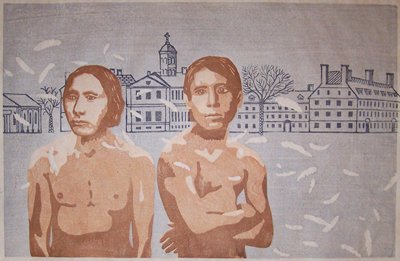Today's postings
- [Baren 40813] Baren Member blogs: Update Notification (Blog Manager)
Digest Appendix
Postings made on [Baren] members' blogs
over the past 24 hours ...
Subject: Boxwood adventures ...
Posted by: Dave Bull
|
Unlike the previous Hanga Treasure Chest series, the prints in this one will have a 'unified' appearance. In the old days, whenever prints were issued in sets, it was common to include a 'cartouche' as part of the design, in which both the series title, and the title of each particular print, would be written. And so it will be with this series. But with a slight twist. As has become obvious by now - from the images of the blocks that I have shown - I am making these prints in pairs. Not two copies of the same image side-by-side (which was frequently done whenever a high volume of prints was needed), but two different images from the series. Numbers 1 and 2 are being made together, then 3 and 4 ... etc. etc. You have already seen the block for the decorative border pattern, and could clearly see the way that the two prints are arranged on the block. The next one to be carved will be for the border outlines, the cartouches, and the series title. But because the print title will change each time, it cannot be included on this block, but will be carved together with one of the blocks for each particular design. The cartouche block with the series title, will leave a blank space where the print title will appear later. I made my first dummy images (the one for the pamphlet, etc.) using computer text output for the titles, but for the real prints, I am using real calligraphy. Long-time collector Mrs. Tauchi (who appeared in this newsletter story) has come through again with some beautiful work. It is extremely delicate calligraphy, and contains lines far too thin to be carved on 'normal' cherry wood. I need something harder, and the standard material for this is tsuge (boxwood), the same wood used for traditional wooden combs. This though, brings another problem. In the old days, the carver would look at a design, figure out what parts of it (if any) required boxwood, and then place an order with his block supplier for a plank with inlays at the appropriate place(s), all planed perfectly smooth, ready to go. But the last traditional block supplier (Shimano Shintaro) died more than 10 years ago, and in any case, he didn't do this kind of work anyway. Each time I have needed boxwood inlays in my blocks, I have had . . . |
This item is taken from the blog Woodblock RoundTable.
'Reply' to Baren about this item.
Subject: Indians and Harvard College
Posted by: Annie B
This item is taken from the blog Woodblock Dreams.
'Reply' to Baren about this item.
